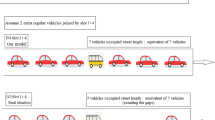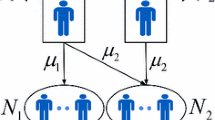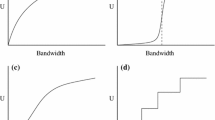Abstract
We consider a fluid model of a system that handles multiple classes of traffic. The delay and cell-loss requirements of the different classes of traffic are generally widely different and are achieved by assigning different buffers for different classes, and serving them in a strict priority order. We use results from the effective bandwidth of the output processes (see Chang and Thomas (1995)) to derive simple and asymptotically exact call-admission policies for such a system to guarantee the cell-loss requirements for the different classes assuming that each source produces a single class traffic. We compare the admission-control policies developed here with the approximate policy studied by Elwalid and Mitra (1995) for the case of two-class traffic.
Similar content being viewed by others
References
C.S. Chang and J.A. Thomas, Effective bandwidth in high-speed digital networks, IEEE Journal on Selected Areas in Communications 13(6) (1995) 1091–1100.
C.S. Chang and T. Zajic, Effective bandwidths of departure processes from queues with time varying capacities, in: '95 (1995) pp. 1001–1009.
G.L. Choudhury, D.M. Lucantoni and W. Whitt, On the effectiveness of effective bandwidths for admission control in ATM networks, in: Proceedings of ITC-14 (Elsevier Science, B.V., 1994) pp. 411–420.
I. Çidon, R. Guérin and A. Khamisy, On protective buffer policies, Technical Report RC 18113, IBM Research Division (1992).
I. Çidon, L. Georgiadis, R. Guérin and A. Khamisy, Optimal buffer sharing, IEEE Journal on Selected Areas in Communications 13(7) (1995) 1229–1240.
G. de Veciana, C. Courcoubetis and J. Walrand, Decoupling bandwidths for networks: A decomposition approach to resource management, in: '94 (1994) pp. 466–473.
A.I. Elwalid and D. Mitra, Fluid models for the analysis and design of statistical multiplexing with loss priorities on multiple classes of bursty traffic, IEEE Trans. Communications 42(11) (1992) 2989–3002.
A.I. Elwalid and D. Mitra, Effective bandwidth of general Markovian traffic sources and admission control of high-speed networks, IEEE/ACM Trans. on Networking 1(3) (1993) 329–343.
A.I. Elwalid and D. Mitra, Analysis, approximations and admission control of a multi-service multiplexing system with priorities, in: '95 (1995) pp. 463–472.
A.I. Elwalid, D. Heyman, T.V. Lakshman, D. Mitra and A. Weiss, Fundamental bounds and approximations for ATM multiplexers with applications to video teleconferencing, IEEE Journal on Selected Areas in Communications 13(6) (1995) 1004–1016.
R.J. Gibbens and P.J. Hunt, Effective bandwidths for the multi-type UAS channel, Queueing Systems 9 (1991) 17–28.
G. Kesidis, J. Walrand and C.S. Chang, Effective bandwidths for multiclass Markov fluids and other ATM sources, IEEE/ACM Trans. on Networking 1(4) (1993) 424–428.
V.G. Kulkarni, Effective bandwidths for Markov regenerative sources, Queueing Systems 24 (1996) 137–154.
V.G. Kulkarni and T. Rolski, Fluid model driven by an Ornstein- Ühlenbeck Process, Probab. Engrg. Inform. Sci. 8 (1994) 403–417.
V.G. Kulkarni, L. Gün and P.F. Chimento, Effective bandwidth vectors for multiclass traffic multiplexed in a partitioned buffer, IEEE Journal on Selected Areas in Communications 13(6) (1995) 1039–1047.
A.Y.-M. Lin and J.A. Silvester, Priority queueing strategies and buffer allocation protocols for traffic control at an ATM integrated broadband switching system, IEEE Journal on Selected Areas in Communications 9(9) (1991) 1524–1536.
A. Narayanan and V.G. Kulkarni, First passage times in fluid models with an application to twopriority fluid systems, in: '96 (1996).
W. Whitt, Tail probabilities with statistical multiplexing and effective bandwidths for multiclass queues, Telecommun. Syst. 2 (1993) 71–107.
J. Zhang, Performance study of Markov-modulated fluid flow models with priority traffic, in: '93 (1993) pp. 10–17.
Z.L. Zhang, D. Towsley and J. Kurose, Statistical analysis of generalized processor sharing scheduling discipline, IEEE Journal on Selected Areas in Communications 13(6) (1995) 1071–80.
Z.L. Zhang, D. Towsley and J. Kurose, Call admission control scheme under the generalized processor sharing scheduling discipline, Technical Report UM-CS–95–10, University of Massachusetts (1995).
Author information
Authors and Affiliations
Rights and permissions
About this article
Cite this article
Kulkarni, V., Gautam, N. Admission control of multi-class traffic with service priorities in high-speed networks. Queueing Systems 27, 79–97 (1997). https://doi.org/10.1023/A:1019153812927
Issue Date:
DOI: https://doi.org/10.1023/A:1019153812927




